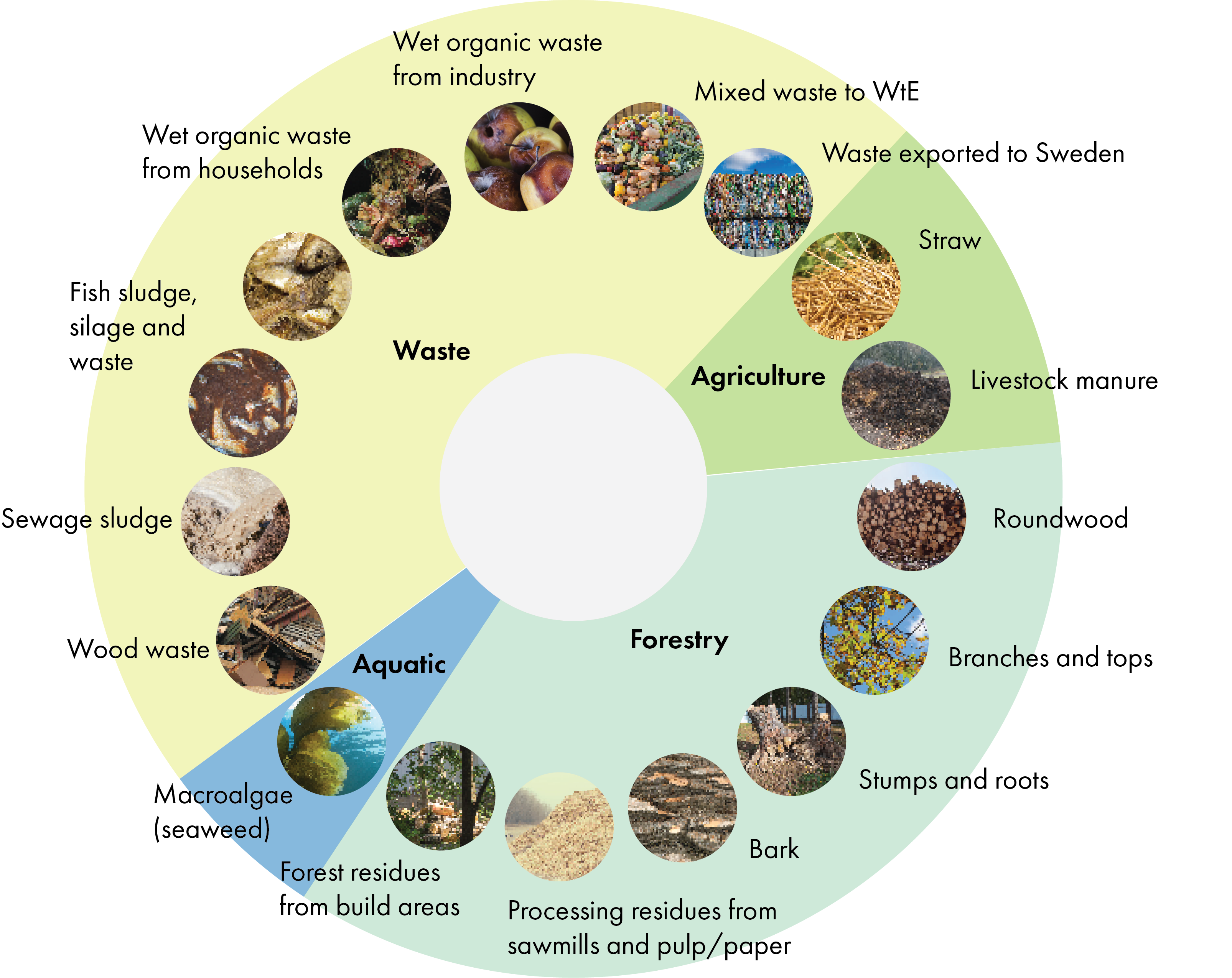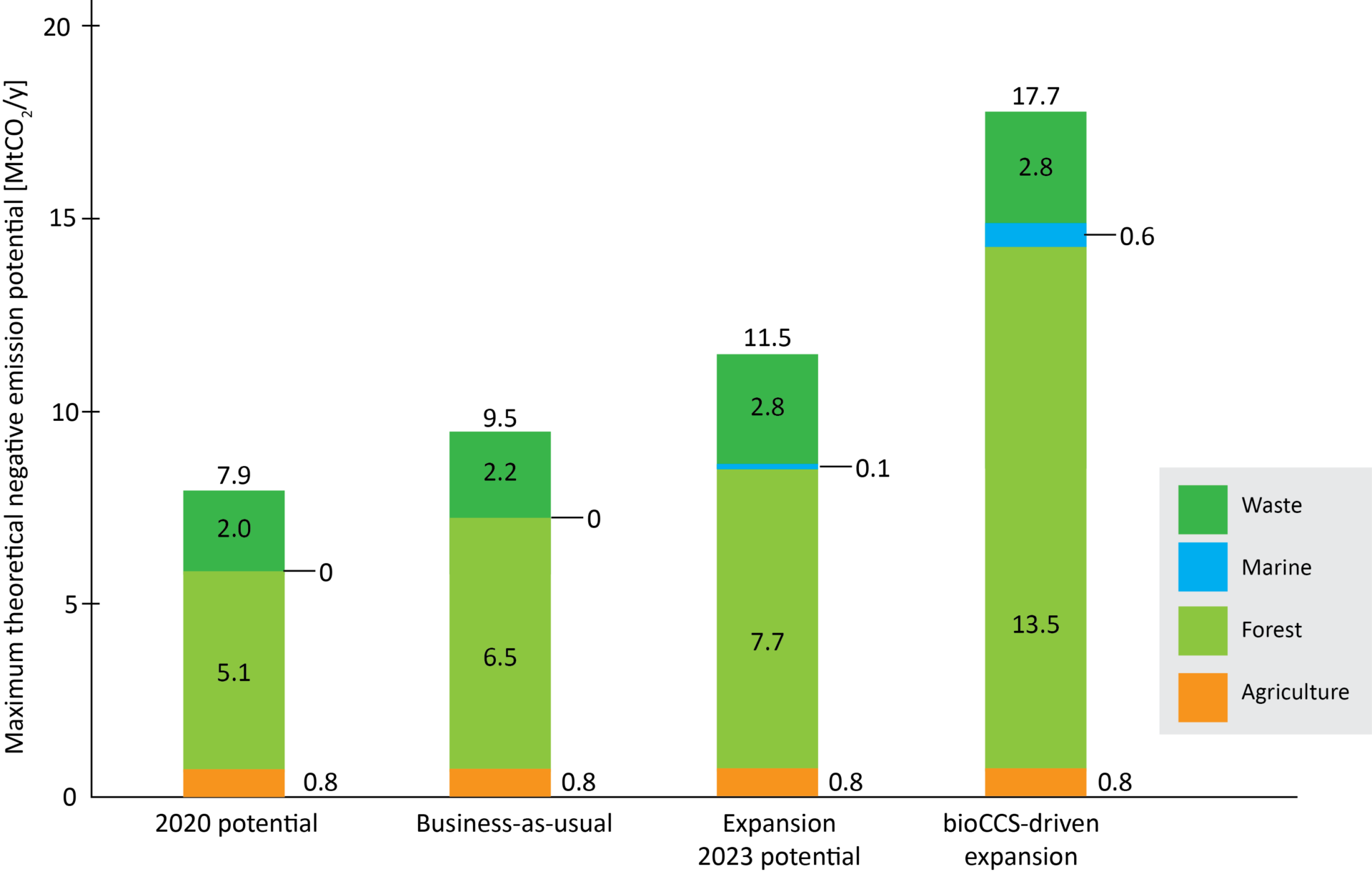Why is bioCCS important?
However, while it is expected to be a main component of global climate action, key questions for Norway are: how much biomass is available, and how much can be used for bioCCS?
Negative emissions are necessary to reach the climate goals we have set for Norway and for the world. While there are various negative emissions pathways (afforestation, mineralisation, direct air capture, etc.), one that has gained attention over the past decade is bioenergy production with carbon capture and storage (bioCCS).
BioCCS refers to a method of removing carbon dioxide from the atmosphere. The biomass acts as a carbon sink during its growth phase, absorbing CO2 from the atmosphere through photosynthesis. When biomass is converted to energy or other valuable products, the resulting CO2 emissions are actively and permanently captured and stored. The overall process can effectively result in a net removal of CO2 from the atmosphere, i.e. negative emissions (Figure 1).
While many studies assume that biomass is readily available for generating negative emissions through bioCCS, there is a limited understanding of how much and what types of biofeed stocks could be used for this purpose. This step is crucial, as it is necessary for understanding the maximum and realistic levels of negative emissions that could be delivered, identifying pathways for integrating these biofeedstocks with bioCCS, evaluating their techno-economic and environmental performances, and understanding the associated advantages and challenges.
Therefore, SINTEF Energy Research has been focusing on trying to better understand the negative emissions potential of bioCCS in Norway. Our new study, published in Sustainable Materials and Technologies, has found that Norwegian biomass could result in negative emissions of between 1 and 13 Mt CO2/year.

Where do we start?
Biomass is described and characterized in different ways in different sectors. Reporting practices (categories, quantities, properties) also differ from sector to sector, and, in many cases, do not include complete information (such as water content), making it difficult to estimate the carbon quantities involved.
As part of the NCS C+ project, we mapped the main forms of biomass in Norway (see Figure 2), including its composition and amounts as well as its current uses. This can then be used to estimate a negative emissions potential window for bioCCS in Norway.

How do you estimate future biomass quantities and bioCCS potential?
For this work, we used a ground-up approach with a four-step methodology. We mapped and used the amount of biomass in Norway in 2020 as a “baseline”, and looked at historical trends. In some cases, we found data from the last hundred years!
We then defined three scenarios in order to assess the future biomass potential, and further identify the maximum (and then most likely) potential of bioCCS.
The methodology can be described as follows:
- Map biomass in Norway in 2020.
- Predict the amount of biomass in 2030 according to three different scenarios:
- What will it look like if we continue as before?
- What will it look like if we use more of the available biomass?
- What will it look like if we change the target so that bioCCS is a driver for even more biomass production and utilization in Norway in a sustainable manner (for example, if we cultivate kelp production specifically for bioCCS)?
- Identify maximum potential by integrating different biomass types with bioCCS in the scenarios from step 2.
- Look at these biomass quantities, and find out how much can most likely be integrated with bioCCS based on two main factors: access to biogenic carbon and the level of negative emissions enabled by that available biogenic carbon.
One key assumption was that the production of food and other products should not be affected. Only bioenergy sectors and biomass that are poorly utilized or not utilized at all were considered for bioCCS, provided that they were sustainable and environmentally friendly. From this there were many exciting results!
Where is our biggest potential?

The largest quantities of biomass for potential integration with bioCCS are from forestry resources, specifically forestry residues. All results included the very important assumptions that the standing forest volume should not decrease over time and that stumps, roots and a fraction of tops and branches should remain in the forest to ensure soil stability and nutrient availability.
The next area of opportunity is waste fractions, such as combustible waste fractions (demolition wood, municipal solid waste) and waste from industries such as fisheries. Exported wastes provide a particularly straightforward opportunity. The vast majority of Norwegian exported waste is sent to Sweden, where it is disposed of along with energy recovery
Finally, while biomass from seaweed and agriculture are shown to have a limited potential now, increased seaweed farming could lead to increased availability in the second half of the century.
How does this potential translate to negative emissions?
Based on our combined biomass mapping and evaluation of their bioCCS availability, we concluded that prudent use of Norwegian biomass can enable negative emissions of between 0.8 and 13 Mt CO2/year, and will most likely be 2 to 8 Mt CO2/year in the coming decades. The more realistic/attainable window is based on two major factors: access to biogenic carbon and the level of negative emissions achieved from that biogenic carbon.

These values are significantly higher than what has been reported previously, emphasizing the importance of using a ground-up approach like the one used here. They also present an exciting opportunity for Norway’s net-zero target. To put these numbers into perspective, Norway’s annual CO2 emissions in 2022 were approximately 49 MtCO2 equivalents per year (StatBank source table 13931).
How do we get started with bioCCS?
While these results highlight the strong potential of Norway to deliver negative emissions, several aspects require further attention:
- Increased knowledge on how to deploy bioCCS value chains in the Norwegian context must be developed. This is critical to understand the optimal integration of biomass resources with bioCCS, the preferred energy products considering Norwegian specificities, associated costs and emissions, as well as the level of incentives required to enable deployment.
- Technologies for converting relevant biomasses to highly decarbonized energy products (heat, power, hydrogen) must be available. While this is likely the case for converting forestry and waste biomass to heat and power, further development and maturation may be required for converting wet biomasses from agriculture and seaweed farming and for cost-efficiently converting biomass to hydrogen.
- Suitable policy and economic frameworks must be put in place to achieve deployment. This ranges from providing financial incentives to support the higher costs that arise with early movers, to supporting cross-sector collaborations (biomass production, energy production, carbon capture and storage), and establishing a certification framework as well as high-quality carbon offset markets.
- Finally, aspects related to sustainability and the social acceptance of bioCCS should be better understood, especially when the biomass is of forestry origin, when there is competition for biomass resources with other sectors such as biofuel or biochar production, and considering the impact on biodiversity, resource recycling, etc.
Read the article about this work: https://www.sciencedirect.com/science/article/pii/S2214993724000927?via%3Dihub
Read more about the project: https://www.sintef.no/en/projects/2021/ncs-c-the-norwegian-continental-shelf-a-driver-for-climate-positive-norway/about-ncs-c/













Comments
No comments yet. Be the first to comment!